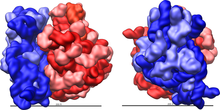Ribosome
Ribosomes are important cell organelles. They are machines: tiny molecular robots which make proteins. They do RNA translation, building proteins from amino acids using messenger RNA as a template. Ribosomes are found in all living cells, prokaryotes as well as eukaryotes.
A ribosome is a mixture of protein and RNA that starts being made in the nucleolus of a cell. The nucleolus is in the nucleus. The nucleus is protected by the nuclear envelope, and lets things out through the nuclear pores. Ribosomes move from the nucleolus into the cytoplasm. Most ribosomes sit on the endoplasmic reticulum, but are also found throughout the cytoplasm.
The job of the ribosome is to make new proteins. It does this by moving along a strand of messenger RNA and building a protein based on the code it reads. Making a protein this way is called translation.
We need up to 10 million robots (ribosomes) in every cell. To get this number, cells have many copies of rRNA genes. We inherit about 400 rRNA genes across five different chromosomes.[1][2]


Structure

Ribosomes are made out of two things: a small ribosomal subunit that reads the mRNA, while the large subunit joins amino acids to form a polypeptide chain. Each subunit is composed of one or more ribosomal RNA (rRNA) molecules and a variety of proteins.
Eukaryotes have 80S ribosomes, each consisting of a small (40S) and large (60S) subunit.[3][4][5] Their small subunit has a 16S RNA sub-unit (consisting of 1540 nucleotides) bound to 21 proteins. The large subunit has a 5S RNA (120 nucleotides), a 28S RNA (4700 nucleotides), a 5.8S RNA (160 nucleotides) subunits and 46 proteins.[4][6][7]
Types of ribosome
Ribosomes evolved as cells evolved. Prokaryote (bacterial) ribosomes have just a single RNA chain. Archaeal ribosomes are similar.
Only Eukaryotic ribosomes have the full gear, which is a total 80S ribosome with a small 40S unit plus a large 60S subunit.